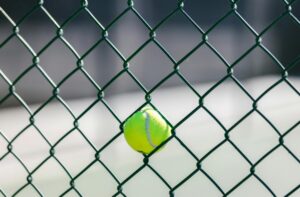As a dog owner and garden enthusiast, I know firsthand how challenging it can be to keep our furry friends out of the garden. Dogs love to dig, chew, and explore, which can wreak havoc on your carefully planted flowers and vegetables. Thankfully, there are several cost-effective fencing solutions that can help keep dogs out of your garden without breaking the bank. In this guide, I’ll share ten DIY ideas that are both budget-friendly and easy to implement.
Why Do You Need to Keep Dogs Out of the Garden?

Protecting Plants and Flowers
Preventing Digging and Trampling: Dogs have a natural instinct to dig and explore. This can lead to uprooted plants, disturbed soil, and a generally messy garden. By installing a fence, you can protect your plants from being dug up or trampled.
Keeping Plants Safe from Being Chewed On: Many dogs like to chew on plants, which can damage or even kill them. Certain plants can also be toxic to dogs, making it crucial to keep them separate.
Maintaining Garden Aesthetics
Avoiding Damage to Garden Layout: A well-maintained garden takes a lot of effort, and it’s disheartening to see all that hard work go to waste because of a playful dog. Fencing helps preserve the structure and beauty of your garden.
Preserving the Beauty of the Garden: Consistent digging and running can damage the visual appeal of your garden. A fence ensures that your flowers, shrubs, and vegetable beds remain intact and beautiful.
Ensuring Dog Safety
Preventing Dogs from Ingesting Harmful Plants: Some garden plants can be toxic to dogs if ingested. A fence keeps your pets away from these hazards.
Keeping Dogs Away from Garden Tools and Chemicals: Gardening tools and chemicals can pose significant risks to dogs. By fencing off your garden, you can prevent accidental injuries and poisoning.
What Tools and Materials Do You Need?

Basic Tools
Before starting any fencing project, gather the following tools:
- Measuring Tape: For accurate measurements to ensure a well-fitted fence.
- Hammer and Nails: Basic tools for assembling wooden fences.
- Screwdriver: Essential for attaching screws and securing panels.
- Wire Cutters: Necessary for cutting chicken wire or mesh fencing.
- Shovel: For digging holes to place stakes or posts.
Common Materials
Depending on the fencing method you choose, you will need:
- Wooden Stakes: Provide support for various types of fencing.
- Chicken Wire: A versatile and affordable option for dog-proof fencing.
- Plastic Mesh: Durable and weather-resistant, suitable for a temporary solution.
- Picket Fence Panels: For a more decorative and permanent solution.
- Bamboo or Reed Fencing: Natural and eco-friendly, blending well with garden aesthetics.
- Garden Netting: Ideal for creating barriers without obstructing the view.
- Zip Ties: Useful for securing materials together quickly and easily.
Best 10 DIY Ideas for Cheap Fencing To Keep Dogs Out
1. Using Chicken Wire

Step-by-Step Guide on Installing Chicken Wire:
- Measure and Cut: Measure the area you want to fence off and cut the chicken wire to the appropriate length.
- Place Stakes: Drive wooden stakes into the ground at regular intervals around the garden.
- Attach Chicken Wire: Use zip ties or staples to attach the chicken wire to the stakes.
- Secure the Bottom: Make sure the bottom of the wire is firmly anchored to the ground to prevent dogs from digging underneath.
Benefits of Using Chicken Wire: Chicken wire is inexpensive, easy to work with, and effective at keeping dogs out of the garden.
2. Plastic Mesh Fencing

How to Set Up Plastic Mesh Fencing:
- Measure and Cut: Determine the amount of plastic mesh you need and cut it to size.
- Install Stakes or Posts: Drive stakes or posts into the ground to support the mesh.
- Attach the Mesh: Secure the mesh to the stakes using zip ties or garden wire.
Durability and Affordability: Plastic mesh is weather-resistant, making it a durable and cost-effective option for garden fencing.
3. Wooden Picket Fence

Building a Basic Picket Fence:
- Measure and Plan: Measure the perimeter of your garden and plan the layout of the fence.
- Cut and Sand the Wood: Cut wooden planks to the desired length and sand any rough edges.
- Install Posts: Dig holes for the fence posts and set them in place with concrete.
- Attach Pickets: Nail or screw the pickets to the posts, leaving small gaps between them for airflow.
Enhancing Garden Aesthetics: A wooden picket fence adds a charming, classic look to your garden while keeping dogs out.
4. Bamboo or Reed Fencing

Attaching Bamboo or Reed Fencing:
- Measure and Cut: Measure the required length of bamboo or reed fencing.
- Install Support Stakes: Drive stakes into the ground to support the fencing.
- Attach the Fencing: Secure the bamboo or reed panels to the stakes using zip ties or wire.
Natural and Eco-Friendly Options: Bamboo and reed fencing blends well with garden surroundings and is environmentally friendly.
5. Garden Netting

Installing Garden Netting for Protection:
- Measure and Cut: Cut the garden netting to the appropriate size.
- Place Support Stakes: Install stakes at intervals around your garden.
- Attach Netting: Use zip ties or garden clips to secure the netting to the stakes.
Versatility and Ease of Installation: Garden netting is lightweight, easy to install, and can be adjusted as needed.
6. Pallet Fencing

Repurposing Wooden Pallets as a Fence:
- Source Pallets: Obtain wooden pallets from local suppliers or businesses.
- Prepare the Pallets: Clean and sand the pallets to remove any rough spots.
- Install Pallets: Stand the pallets upright and secure them together using nails or screws.
Cost-Effectiveness and Availability: Wooden pallets are often free or very cheap and can be easily repurposed into a sturdy fence.
7. Hedge Barriers

Planting and Maintaining Hedge Barriers:
- Choose Hedge Plants: Select fast-growing hedge plants suitable for your climate.
- Plant the Hedges: Space the plants evenly around the garden perimeter.
- Maintain the Hedge: Regularly water, prune, and fertilize the hedge to ensure it grows thick and tall.
Natural Look and Long-Term Solution: Hedge barriers create a living fence that adds natural beauty and provides long-term protection.
8. Wire Fencing with Wooden Stakes

Combining Wire Fencing with Wooden Stakes:
- Measure and Cut Wire: Cut the wire fencing to the desired length.
- Install Wooden Stakes: Drive stakes into the ground at regular intervals.
- Attach Wire to Stakes: Secure the wire fencing to the stakes using staples or zip ties.
Steps for Secure Installation: Ensure the wire is taut and securely fastened to prevent dogs from pushing through or digging under.
9. Portable Dog Playpen Fencing

Setting Up a Portable Dog Playpen:
- Purchase a Playpen: Choose a portable dog playpen that suits your needs.
- Assemble the Playpen: Follow the manufacturer’s instructions to assemble the playpen.
- Place in Garden: Position the playpen around the area you want to protect.
Flexibility and Convenience: Portable playpens can be easily moved and adjusted, providing a flexible fencing solution.
10. DIY Wattle Fence

Crafting a Traditional Wattle Fence:
- Gather Materials: Collect thin branches or saplings for weaving.
- Install Upright Stakes: Drive sturdy stakes into the ground at intervals.
- Weave Branches: Weave the branches in and out of the stakes to form a fence.
Rustic Charm and Functionality: A wattle fence adds a rustic touch to your garden while effectively keeping dogs out.
How to Choose the Right Fencing for Your Garden?
Considering Your Garden Layout
Assessing the Garden Space and Layout: Measure your garden and consider its shape and size when choosing a fencing solution. Ensure the fence fits well with the existing layout.
Choosing a Fence That Complements Your Garden: Select a fence that enhances the aesthetic appeal of your garden. Consider the materials and design that best suit your garden’s style.
Evaluating Dog Behaviour
Understanding Your Dog’s Habits and Behaviour: Observe your dog’s behaviour to determine the best type of fence. Some dogs are jumpers, while others are diggers. Choose a fence that addresses these tendencies.
Selecting a Fence Based on Your Dog’s Tendencies: If your dog likes to dig, opt for a fence that extends below ground. For jumpers, choose a taller fence to prevent them from leaping over.
Balancing Budget and Durability
Finding a Balance Between Cost and Durability: While it’s important to stay within budget, consider investing in durable materials that will last longer and provide better protection.
Investing in Materials That Last: Look for materials that are weather-resistant and require minimal maintenance, ensuring your fence remains effective for years to come.
Maintenance and Care for Your Garden Fence
Regular Inspection
Checking for Damage or Wear: Regularly inspect your fence for any signs of damage or wear. Look for loose posts, broken wires, or gaps that need repair.
Making Necessary Repairs Promptly: Address any issues immediately to prevent further damage and maintain the effectiveness of your fence.
Cleaning and Upkeep
Keeping the Fence Clean and Free of Debris: Clean your fence periodically to remove dirt, leaves, and other debris that can accumulate.
Seasonal Maintenance Tips: Perform seasonal maintenance, such as applying weatherproofing treatments to wooden fences and checking for damage after storms.
Cheap Fence Options and Costs To Keep Dogs Out Of Garden
| Method | Materials Needed | Estimated Cost | Difficulty Level |
| Chicken Wire | Chicken wire, stakes, zip ties | Low (£10-£30) | Easy |
| Plastic Mesh Fencing | Plastic mesh, stakes, zip ties | Low (£15-£40) | Easy |
| Wooden Picket Fence | Wood planks, nails, posts | Moderate (£30-£70) | Moderate |
| Bamboo or Reed Fencing | Bamboo/reed panels, zip ties | Low to Moderate (£20-£50) | Easy |
| Garden Netting | Garden netting, stakes, zip ties | Low (£10-£30) | Easy |
| Pallet Fencing | Wooden pallets, nails, screws | Very Low (Free-£20) | Moderate |
| Hedge Barriers | Hedge plants, soil, water | Variable (£20-£100+) | Moderate |
| Wire Fencing with Stakes | Wire fencing, wooden stakes, staples | Low (£15-£40) | Easy |
| Portable Dog Playpen Fencing | Playpen panels, connectors | Moderate (£30-£80) | Easy |
| DIY Wattle Fence | Branches, stakes | Low (£10-£30) | Moderate |
By following these guidelines and choosing the right fencing solution, you can enjoy a beautiful, dog-proof garden that keeps both your plants and pets safe.
Conclusion
Creating a dog-proof garden doesn’t have to be expensive. With these ten DIY fencing ideas, you can keep your furry friends out of your garden while enhancing the beauty and functionality of your outdoor space. Whether you choose chicken wire, bamboo fencing, or a wooden picket fence, there’s a solution to fit every budget and garden style. Regular maintenance and thoughtful planning will ensure your fence remains effective for years to come. Happy gardening!
Frequently Asked Questions
Can I Install a Garden Fence by Myself?
Yes, many garden fences can be installed as DIY projects with basic tools and materials. Follow the step-by-step guides provided for each fencing method.
How Much Does It Cost to Build a Cheap Garden Fence?
The cost depends on the materials and size of your garden. Simple solutions like chicken wire or garden netting are usually more affordable, while wooden picket fences or bamboo fencing may cost more.
What Is the Best Type of Fence to Keep Dogs Out?
The best type of fence depends on your specific needs and your dog’s behaviour. For diggers, a fence that extends below ground is ideal. For jumpers, choose a taller fence. Options like chicken wire, plastic mesh, and wooden picket fences are effective and budget-friendly.


0 Comments